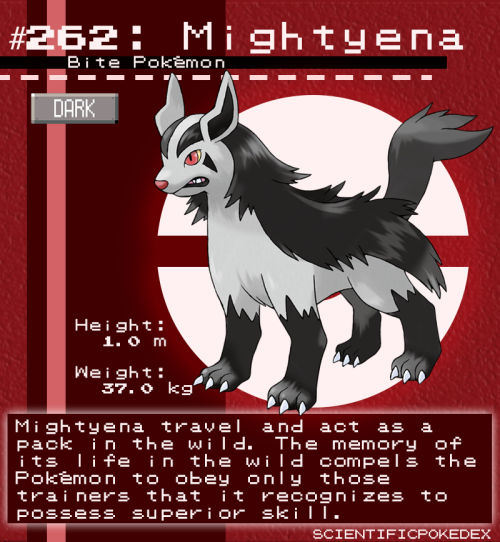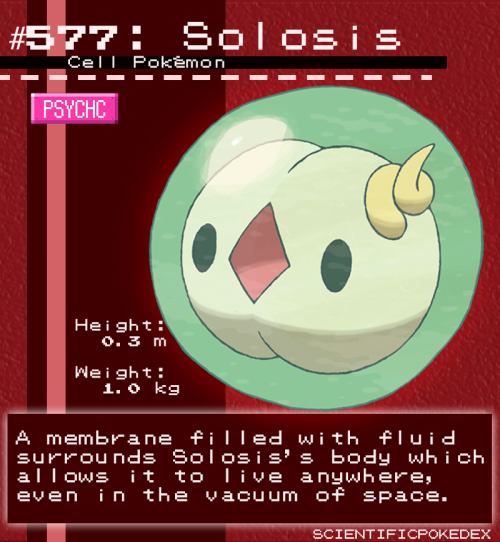#pokemon science
Now is your chance to get a copy of the scientific textbook that’s helping people of all ages understand the power that’s inside!

PokéNatomy is an unofficial anatomical art project, re-imagining Pokémon through the lens of modern biology. You can own incredible scientific world of Pokémon in print in a high-quality, fully illustrated, unofficial guidebook.
Your copy will be one of only 1,500 books in existence!

This one of a kind artbook was fully funded on Kickstarter, and after being unavailable for over 3 months for reprints, is again available for sale!
The book is 300 pages long and contains all of the original 151 Pokémon, with full page anatomical illustrations for each Pokémon as well as detailed descriptions of their biology, behavior, and abilities.

PokéNatomy is suitable for all ages, and designed to clarify and explain diverse scientific concepts like DNA, body systems, hereditary traits, and adaptation all through the wonder and weirdness of classic Pokémon characters!
If you haven’t yet ordered your copy, and would like to do so
Requested by @bmmi20
According to the pokédex, Mightyena in the wild are often found in packs, traveling and hunting in groups around the Hoenn region. To learn more about this pokémon behavior, let’s turn to the analog in our world, a pack of wolves!

In the wild, wolf packs are almost always families, consisting of one pair of parents and their children. Wolves typically have 4-6 pups a year, and the children stay with the pack for up to 3 years until they leave to make packs of their own. Thus, the typical wolf pack has between 6 - 20 wolves at any given time.
The idea that wolf packs have a dominant “alpha male”, which all the other wolves fear and respect, is outdated and has been debunked. Historically, wolf behavior was studied using captive groups of wolves, like those found in zoos for example. These animals were not family groups like real packs, but rather unrelated rescues, or wild-caught creatures that are housed together. The fact that they are not related, and the fact that captive animals tend to be more aggressive in general (especially if they are not receiving adequate care), meant that the scientists studying the wolves observed a lot of hostile behavior, and the “alpha” hierarchy emerged where the strongest, most aggressive wolf was dominant.
In the wild, wolves simply don’t do that. Wolves within a pack rarely fight with each other at all. The point of a pack is to have safety and strength in numbers, and to care for and defend the younger, weaker pups as they grow up. If wolves were constantly fighting for dominance, that would defeat the entire purpose of a pack. As mentioned before, wolf packs in the wild are family groups. The closest thing to an “alpha male” is the parent wolves, who do lead the pack, care for their pups, decide when and where to hunt and eat, and occasionally discipline their pups. This picture of a strong family unit is far from the aggressive hierarchal structure people used to associate with wolves.
Mightyena live and travel in packs, usually made of two parents and up to 3 years of Poochyena pups. Mightyena do not respect and obey trainers that they perceive as stronger than them, but rather form the strongest bonds with trainers that care for and protect the Mightyena, like the parents in the pack do for their cubs.
Post link
Requested Anonymously
Fennekin is one of those pokémon that has a near-perfect counterpart in our world. In this case, behold, the Fennec Fox:

It shares Fennekin’s fox-like appearance, golden-colored fur, small stature, and of course, its very large and very adorable ears. Fennec foxes are native to the Sahara desert in North Africa. They are the smallest foxes on our planet, growing only to about 16 inches (0.4 m) long - exact same as Fennekin is listed in the pokédex!
Fennekin’s pokédex entry tells us that Fennekin commonly eats sticks. Fennec foxes primarily eat insects, but also eat plenty of roots and leaves in their diet like Fennekin as well! Scientists think that they eat these mostly for the plant’s water content - water is hard to come by in the deserts where they live, so eating plants is how these foxes stay hydrated.
But what about those huge ears?

The first reason that these foxes have such large ears is because it helps them hunt their food. Since they eat bugs, they need to be able to hear faint sounds of bugs moving underground in order to hunt their prey. They are known to tilt their ears from side to side, listening for movement underground, before digging up their meal. Their large ears make it possible to hear such tiny sounds, making it easier for them to eat.
The other benefit to having such large ears is that their large surface area helps radiate away the fox’s body heat, keeping it cool in the hot desert environment. Human’s sweat to help regulate our temperature, but for a desert creature like the Fennec fox, water is precious, and you can’t waste any by sweating it away. So, it’s expansive ears, which are filled with blood vessels close to the surface of its skin, help dissipate off that excess heat and helps the fox stay cool. This is called thermoregulation, and the pokédex tells us that Fennekin does it too! As a fire type pokémon, Fennekin is probably very hot all the time - it’s large ears make it possible to regulate its body temperature efficiently.
Fennekin’s large ears help it hunt bug pokémon underground, and regulate its body temperature by expelling excess heat through the ear’s large surface area. It eats plant material to help stay hydrated.
Post link
Requested Anonymously
Cherrim is a unique pokémon, who changes form depending on the weather. Most of the time, Cherrim keeps its flower closed, hiding beneath its tightly folded purple petals. In strong sunlight however, Cherrim blooms, opening up and becoming a beautiful pink flower.

This type of behavior, a flower opening or closing its petals or leaves in response to sunlight, is called nyctinasty.There are plenty of nyctinastic flowers in our world, including tulips, the common daisy, magnolias, crocuses, and water lilies, which all share this common trait of folding up during the night, and blooming during the day.

Nyctinastic plants, like Cherrim, contain specialized pigments which sense and absorb light. You’ve probably heard of chlorophyll, a pigment that all plants have, that helps plants photosynthesize and absorb energy from sunlight. Nyctinastic plants additionally have a pigment called phytochromes, which detects red light specifically, allowing the plant to “see” when more red light is in the sky - typically near sunrise or sunset.
The interesting part is that many of these flowers will settle into a regular schedule, opening even on overcast days when the sun is out, or closing even when kept in a bright room at night. This leads scientists to believe that nyctinastic plants have a circadian rhythm, an internal clock, similar to the human’s sleep cycle. Just like when a human’s body tells them they need sleep every night, these plants can sense when it’s time to fold or open on schedule.
Scientists aren’t really sure why nyctinastic plants do their thing, but there are several strong theories. Pollen, the way that plants reproduce, loses its viability if it gets too wet, so it’s possible that these plants curl up to keep their pollen safe and dry, away from cold temperatures and morning dew. During the day, water evaporates easily in the sunlight, and bees are awake to spread the pollen around.
This doesn’t apply to every flower though. Moonflowers (pictured below) are an unusual type of nyctinastic flower which blooms during the night, and closes during the day. It likes the cooler temperatures, and scientists think that it does this to help gather water, instead of keep it away - the moonflower’s open petals collect dewdrops at night, and it curls up during the day to prevent the water from evaporating, so it can trickle down its stem and feed its roots.

Even though they why still may be a mystery, nyctinastic plants are very cool. Their ability to open and close their petals, and even sense the passing of time, reveals that plants are more complex than most people know.
Cherrim is a nyctinastic plant, who opens and closes its petals in response to sunlight. Its petals contain a special pigment called a phytochrome which senses sunlight, allowing it to know when to open or close.
Post link
Requested by @tsukixnoxme
Alakazam, the classic first generation psychic pokémon, is known for being very, very smart. The pokédex entry in various games tell us that this is attributed to the large size of Alakam’s brain, which continuously grows larger over the course of its life.
Contrary to popular belief, there is little evidence that shows that having a larger brain makes an animal more intelligent. If that were true, whales would be the smartest animals on Earth, because they have the largest brains. Birds like ravens or crows have small brains, so they should be less intelligent by that logic, and yet, they are regarded as some of the more clever creatures on our planet. Here is a graph of brain sizeversus body size for several animals:

Unsurprisingly, larger animals have larger brains. Even corrected for body weight though, humans, which are typically regarded as the most intelligent creatures on Earth, do not have the largest brain size. If not brain size, then what about the brain determines an animal’s intelligence?
According to this study, it’s the type of brain cells that matters, not just the size. There are hundreds of different types of brain cells, called neurons, that have different roles in the brain. Cortical neurons, for example, are associated with memory, awareness, and consciousness. Sensory neurons translate information from your sensory organs, like your eyes and ears, to the brain. Motor neurons carry signals from your brain to your muscles, allowing you to move. Mirror neurons fire up when an animal observes a behavior in another creature, and then mimics it, and are linked with both empathy and language processing in humans.
Out of all of those, cortical neurons have the most correlation with intelligence in animals. Humans have a very high number of cortical neurons compared to other animals, which scientists think is responsible for our higher intelligence. On average, humans have abut 15 billion cortical neurons in their brain, compared to the 5.6 billion cortical cells in an elephants brain: which is impressive, because an elephant’s brain is much larger by mass. The brain of a cat (25 grams) is about 1/3 the size of the brain of a dog (74 grams), but cats have about twice the number of cortical cells in their brains!
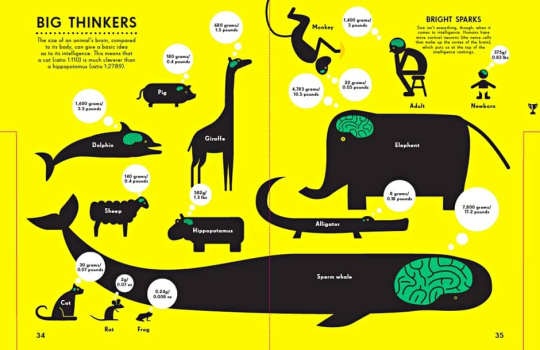
So with that, Alakazam not only has a large, ever-growing brain, but specifically produces more and more cortical neurons over the course of its life, resulting in more memory, higher perception, and, of course, presumably it’s psychic powers. That explains why it is more intelligent than a Wailord!
The process of growing new brain cells is called neurogenesis. Brain cells do not divide to reproduce through mitosis. Rather, they are created inside of stem cells, and live for as long as the body does. While most brain cells are created this way during developmental stages of an animal’s life - as an embryo, egg, or child - neurogenesis does continue through the adult stages of many species, humans included. Our brains, like Alakazam’s, are constantly growing bigger!
Alakazam’s brain contains a large number of cortical neurons, the type of brain cell associated with memory, awareness, and intelligence in animals. Although Alakazam’s brain is smaller in mass than a Wailord’s brain, it has more cortical neurons.
Post link
Requested anonymously
During Cinderace’s signature move, Pyro Ball, this soccer-playing rabbit picks up a pebble and turns it into a ball of flame, kicking it into its rivals for devastating damage.

Rocks may not seem flammable intuitively, but in reality, some of the biggest naturally occurring fireballs in our world have the same humble origin, as a small rock being blasted through the atmosphere. I’m talking about meteors.
Meteors, also known as shooting stars, are rocks from space that burn up as they pass through the Earth’s atmosphere. The rocks themselves are usually fragments that broke off of a comet or asteroid, with sizes ranging from the size of a grain of sand up to the size of a boulder, several meters in diameter. Very bright meteors are called fireballs, for somewhat obvious reasons. Here’s what they look like:

The top two images there are real meteors observed on Earth (the bottom two are artists depictions), large space rocks that crashed through the atmosphere. The reason that meteors become fireballs and burn up in the atmosphere is because of ram pressure. The rock pushes on and compresses all of the air in front of it, building up high pressure and creating a shockwave. Meteors often reach temperatures of over 3000 degrees Fahrennheit this way, which makes the rock glow brightly and actually ignites the air it travels through, creating the signature long streaks of fire through the sky.
Fireball meteors usually don’t survive longer than a few seconds - the rock literally vaporizes, burning up and breaking apart miles before it hits the ground. These rocks are fast,clocking in around a speed of 20 kilometers per second (or 45,000 mph). So that should give you an idea on how hard Cinderace can kick.
Cinderace picks up a pebble and kicks it at speeds greater than 20 kilometers per second, igniting the pebble and turning it into a firey meteor.
Post link
Requested anonymously
The adorable Snorunt thrives in cold temperatures, as low as -150 degrees Fahrenheit according to the pokédex! The lowest temperature ever recorded on our planet is -128.6°F(or -89.2°C), which was measured in Antarctica in 1982. To learn more about how Snorunt lives in similar environments, let’s take a look at one of Antarctica’s residents, the penguin!

Penguins are able to stay warm due to their feathers - they have four layers of different feathers, which trap heat close to their bodies, like wearing four big blankets. They can puff out, or pull in, their feathers as needed to regulate their heat, and just about every part of their body is adapted to lose as little heat as possible as it functions. Penguins also famously huddle together to share warmth, which Snorunt does too! It’s pokédex entry from Black & White says “it is said that several Snorunt gather under giant leaves and live together in harmony.”
Of course, for any of this to apply to Snorunt, we’re making the underlying assumption that Snorunt needs to stay warm in order to survive. It’s possible that through *~*~pokemon magic~*~* Snorunt simply has a very low body temperature and is perfectly comfortable in cold weather. But for basically every animal in our world, including the penguins, the body needs to stay above a certain temperature in order to survive. The chemical reactions, blood circulation, and processes that we rely on to function are significantly slowed in cold temperatures. Besides, there is one piece of evidence that Snorunt needs to keep its body temperature above a certain level, even if it lives in extreme climates: it shivers!

Shivering is a way for muscles to generate heat, by contracting and expanding very quickly. This uses up energy, but ultimately produces heat to raise the body temperature back towards functional levels. If an animal’s body temperature is too cold, the heart has to work harder to pump blood, the cells in the body will shrink and dry out, brain activity slows down, muscles can stop working, and blood vessels can freeze - all of that happens during hypothermia.
There are some animals that can survive with surprisingly cold body temperatures, with clever mechanisms to get around this. There is an arctic squirrel, for example, who’s body temperature reaches a low 28 degrees Fahrenheit (-3 Celsisus) during its hibernation cycle. Similarly, there is a frog who completely freezes solid for months every winter (see our entry on Glaceon). In those examples, the animals’ bodies produce a natural anti-freeze substance that prevents their blood from freezing solid in the extreme cold. It’s likely that Snorunt has the same!
Snorunt’s coat contains different layers of fur to help regulate its body temperature, and it shivers to generate heat in its muscles. Snorunt likely also has a lower resting body temperature than most pokémon, producing cryoprotectants to prevent itself from freezing solid in extreme climates.
Post link
Requested by @mindsnot
Appletun may look sweet, but according to it’s pokédex entry, it’s actually a ruthless predator. Appletun secretes a sweet-smelling nectar through its skin, attracting bug Pokémon for Appletun to then snack on. That’s a pretty brutal, yet effective, strategy for finding lunch. Just ask the pitcher plant:
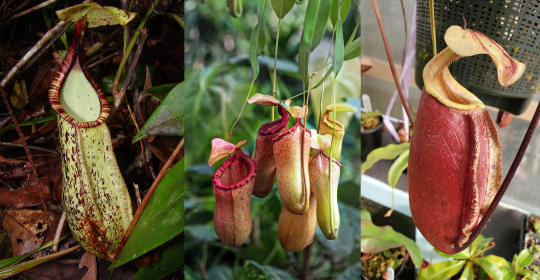
Pitcher plants are a family of carnivorous plants - similar to the Venus Fly Trap - that get their nutrients from eating insects rather than absorbing them from the soil. They typically live in areas where the soil is thin or acidic, and due to the poor soil conditions they can’t get the nutrients they need from their roots like other plants. Instead, they adapted another method of getting what they need: consuming insects!
Pitcher plants in particular are characterized by their cup-shaped leaves, which are filled with a puddle of flower-scented nectar at the bottom. Unsuspecting bugs follow the sweet scent looking for a snack of their own, but end up becoming the snack. Once the insect falls into the cup, the waxy, smooth walls of the leaves make it so the bug can’t climb out again, and it ends up drowning in the pool of nectar. The nectar pool also contains digestive enzymes which helps break down the nutrients for the pitcher plant to absorb, kind of like the acid in your stomach. Appletun’s signature move, Apple Acid, makes a lot of sense in this context: its nectar attracts bug pokémon by the sweet scent, but the nectar is actually acidic, which helps it digest the bug pokémon to eat.
Appletun is part Grass-type, so the pitcher plant is a fair comparison, but it doesn’t explain the fact that Appletun looks more like a dragon than a plant, and the pokédex tells us that its nectar comes from everywhere on its skin, not only in its leaves.
To explain this we can look towards amphibians, like frogs and salamanders, who are known for having slimy skin!

Amphibian skin needs to be wet to properly function: they “drink” through their skin to stay hydrated, and they absorb oxygen through their skin to breathe. It also helps them regulate their body temperature. The “slime” on an amphibians skin is actually a mucous, secreted by many glands throughout their skin, keeping them hydrated. Some salamanders also have beneficial microbes in their slimy coating to boost their immune system. Tree me frogs commonly use their mucous to help stick to leaves and rocks, enabling them to climb, and others have even adapted to secrete poison in it to deter predators.
Appletun’s skin must contain many mucous glands like an amphibian, which constantly secretes the sweet-smelling liquid all over its body. I like to think it has a similar texture, scent, and appearance to apple pie filling. The slime probably has multiple purposes, like a frogs, to help Appletun stay hydrated and regulate its body temperature. But most importantly, the sweet scent attracts bug pokémon, which Appletun can then turn into a tasty snack.
Appletun’s skin contains glands that secret a mucous that smells like sweet plant nectar. This slimy coating helps Appletun stay hydrated, boosts its immune system, and lures in prey for Appletun to eat.
Post link
Requested anonymously
Audino is designated as the “hearing pokémon”, for good reason! According to the pokédex, it cant hear faint sounds from over a mile away, and uses the feelers on its ears to sense emotions and heartbeats. How does that work?
Sound is measured in frequency, typically in units of Hertz. High-pitched sounds have high frequency, and low-pitched sounds have lower frequency. Humans can hear sounds between 20 and 20,000 Hz - but as far as the animal kingdom is concerned, humans have pretty bad hearing. There are lots of animals that can hear sounds that we can’t, just like there are animals that can see colors that we can’t. Bats, owls, dolphins, dogs, and cats are among the animals that have the best hearing in our world, but as it turns out the creature with the absolute best hearing in the world doesn’t even have ears! Let me introduce you to the Greater Wax Moth, galleria mellonella:

The Greater Wax Moth can hear sounds from 7 Hz all the way up to 300,000 Hz, higher than any other animal known! Researchers think that they evolved this ability to help evade their natural predator, the bat, who of course emits high-frequency sounds with echolocation to “see” its surroundings.
The Greater Wax Moth doesn’t have ears, but it does have a sound-detecting organ called a tympanic membrane. The moth’s tympanic membrane is located on its stomach, and it is a small (about 0.5 mm), thin barrier that is extremely sensitive to vibrations, kind of like the human’s eardrum. On a physical level, sound is simply vibrations through the air, so the more sensitive an organ is to vibrations, the better the hearing the creature has. There’s also some evidence that this moth also uses its antenna to sense vibrations, giving it another form of “hearing”. Just like Audino’s ear feelers!
In fact, several of the best listeners in the animal kingdom use more than one part of their body to detect sounds. Elephants, for example, actually use their feet! In addition to their famous large ears, elephants can “hear” with their feet. They have extremely sensitive foot pads, which allow them to feel very faint vibrations in the ground. An elephant can hear the roar of another elephant from over 5 miles away by sensing the vibrations in the ground with its feet.

This has an added benefit, too: sound travels about 4 times faster through solid objects, than it does through air. You can test this yourself by putting your ear on your desk, and softly tapping on the other end - the sound will come more clearly through the desk than it does through the air, with your head up. This is why Audino’s feelers are extremely powerful: by directly touching an object with its feelers, Audino’s sensors can detect even the faintest of vibrations.
That is how Audino can sense emotions, too! Your heart beats faster when you are scared or excited, and your breathing might slow down when you’re relaxed. All of these are sounds that your body makes that Audino can detect! Similarly, it can detect when an egg is close to hatching by feeling the vibrations of the pokémon inside the egg.
Audino has two organs for hearing, its ears and its feelers. Its feelers can pick up very faint vibrations in whatever object they touch, sensing many sounds outside the range of human ears.
Post link

The power of science is staggering! The Scientific Pokédex was created in February 2015 to explore the world of Pokémon through real world science. Using the in-game Pokédex entries, we will explain how Pikachu stores electricity, calculate the speed at which Team Rocket blasts off, discuss the real-world animal inspirations behind your favorite pokémon, and much, much more.
A variety of advanced scientific topics will be discussed, from biology to chemistry and physics, but the goal is always to write clear, understandable, and educational entries. We’re sort of the Mythbusters of the Pokémon Universe.
What Pokémon have you covered so far?
We have a Full Pokédex Page that lists all of the pokémon we have analyzed so far. Check it out to see if we’ve done your favorite! You can also just search on our blog.
Can I request a Pokémon?
Yes!Requests are currently open. Please send your request to our ask box,and we’ll get to it as soon as we can!
Requested by @lowbrr
Solosis is obviously based on a biological cell, the basic structural unit of life. The human brain alone contains over 80 billion individual cells, but there are also billions of single-celled organisms in our world, including amoeba, paramecium, or bacteria. Like a many single-celled organisms in our world, Solosis contains all the typical components of a cell - a stiff outer cell membrane, protecting it from outside hazards; an inner nucleus, where all genetic information is stored as DNA; and gooey cytoplasm, a liquid that cradles all of the other organelles and enables cell growth and replication. Even the little yellow spiral on Solosis’ nucleus has a real counterpart, the endoplasmic reticulum which builds proteins to maintain and grow the cell.

When you think of a single-celled organism like Solosis, you probably think of a tiny, microscopic creatures like an amoeba. You don’t need a microscope to see Solosis though, which stands at over 0.3m tall according to the pokédex! Although rare, there are several single-celled creatures in our world that are big enough to hold in your hand, like Solosis. You might even have one in your fridge - an unfertilized chicken egg is a single cell! More relevant to solosis though, is one of the largest known single-celled organism on Earth, a species of algae called valonia ventricosa, or “bubble algae”.

Bubble Algae are found in tropical areas often in coral reefs, near the Caribbean, Florida, and Brazil. They can grow up to several inches in diameter, but despite their large size, they’re pretty much the exact textbook picture of a cell. Inside they have a nucleus, vacuoles, and chloroplasts, all encompassed in a cytoplasm goo. They even reproduce through mitosis, by splitting themselves in two!
Researchers think that bubble algae is able to grow so large when other cells can’t due to some evolutionary tricks they have up their single-cellular sleeves. First, although the bubble algae is a single cell, they contain many nuclei inside the cell membrane, which each control a small region of the cell and work together to keep the whole thing operating. Second, they have a very large central vacuole, which stores water and helps significantly with the structure of the cell - much like the bones in our body, this vacuole prevents the algae from collapsing in on itself. It also is exceptionally good at personal defense: if the outer membrane gets popped, it will quickly contract to seal up the hole. Solosis likely shares some of these traits, as a large single-cellular organism!
Biology lesson aside, there’s something about Solosis that makes it extra special - according to its pokédex entries, Solosis can survive in the vacuum of space!
If you find yourself in space without a spacesuit, you’re going to have a bad time. There is no oxygen to breathe, and all of the fluids in your body would boil and then freeze in the vacuum, in the span of about 15 seconds. And if you somehow survive that, you’re still bombarded with intense radiation from the sun, no longer filtered by the protection of the Earth’s atmosphere.
Still, there is at least one organism on Earth who, like Solosis, can survive on its own in the vacuum of space: tardigrades!
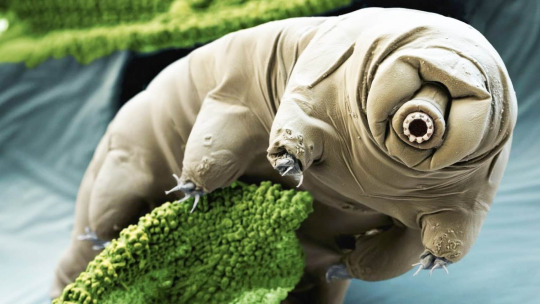
Tardigrades are tiny (albeit multicellular) water-dwelling, moss-eating creatures that are found pretty much everywhere on earth, from your backyard pond, Antartica, the Himalayas, to the 700 degree Fahrenheit hydrothermal vents deep in the ocean. In 2007, the European Space agency sent some of these creatures up to the International Space Station to study how they do in space, where we learned they can survive even after floating freely in the vaccuum!
Their secret to survival is a process called cryptobiosis.Basically, when they encounter a hazardous environment or extreme temperatures, their tiny bodies completely shut down, halting all metabolic function. They can’t move or reproduce, but they also don’t need to eat, drink, or breathe, sort of like an extreme version of sleep. Tardigrades can survive in cryptobiosis for up to 30 years, and then resume life as normal as if nothing ever happened.
Tardigrades also have an extreme resistance to radiation. The more radiation they are exposed to, the faster their cells produce anti-oxidants, which protect cells from damage and help repair any DNA that might be damaged by the radiation. Who knew something so small could be so extreme?
Solosis is a large single-celled organism. If it is exposed to hazardous environments like the vacuum of space, it will enter cryptobiosis and shut down all metabolic function in order to survive.
Post link




